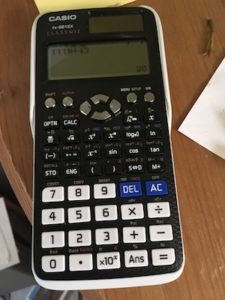Long division
Some time back in the olden days, @robeastaway posted this:
My 11 year old's sample SATs papers found in his book bag. "Work out 1118÷43 (no calculator)." I wish all ministers had to take these tests. pic.twitter.com/dEOiLv2fsJ
— Rob Eastaway (@robeastaway) March 22, 2017
Before I say anything else: I do not consider this a useful question for 11-year-olds or anyone else. I particularly dislike that a method is mandated - long division is a fine algorithm, but I don’t think it’s appropriate to say “you must do sums precisely this way.”
That is not maths. That is computer programming, with students as the computers.
With that off my chest, I thought I might have a look at some of the possible methods for calculating 1,118 ÷ 43.
Long division
You can do it by long division, of course. It may even be your preference.
Here’s how it works:
______2_6_
43 ) 1 1 1 8
0 | | | No 43s go into 1.
=======
1 1 | |
0 | | No 43s go into 11
=======
1 1 1 |
8 6 | Finally! 2 × 43 = 86, so we can write 2 above the last 1.
=======
2 5 8
2 5 8 6 × 43 = 258, so we can put 6 above the 8.
=====
0 No remainder, and we're done.
That tells us the answer is 26 - but there’s a lot that can go wrong there.
Estimate and check
The sum is “a bit more than 1000 divided by a bit more than 40”, so an answer in the region of 25 seems plausible.
Working out 43 × 25 gives 1075, which is 43 short of the target. That means we must need 43 × 26.
Who threw that?!
“Forty-three sevens is 301,” pointed out the Mathematical Ninja. “So you can work out 7826÷301, which is very clearly 26.”
And the Mathematical Ninja was gone.
Algebra
(I know, this might not be perfect for 11-year-olds.)
Let the answer be $10a + b$, since it’s clearly between 10 and 100.
Then $(40+3)(10a+b) = 1118$.
Expanding the brackets gives $400a + (30a + 40b) + 3b$.
We can surmise that $a=2$, because 3 is too high (we’d get 1200 and change), and 1 far too low. That makes the whole thing $800 + 60 + 40b + 3b = 1118$, or $40b + 3b = 258$.
Now, if $b$ were 6, it would make $40b = 240$, which is in the right ballpark - in fact, it’s bang on.
(If we knew that the answer was an integer, we could state immediately that $b=6$ - only numbers that end in 6 give a final digit of 8 when multiplied by 3.)
Chunking
“$2 \times 43 = 86$, so $20 \times 43 = 860$. Take that off, we’ve still got 258. Now, $5\times 43 = 215$, take that off and we’ve still got 43 left over. That’s $1\times 43$, so it’s $26 \times 43$.”
How a normal person would do it
